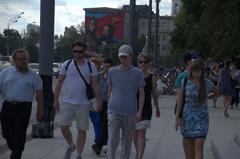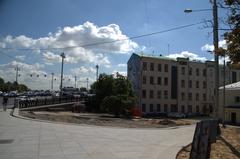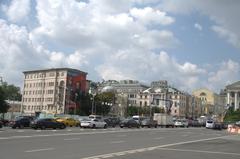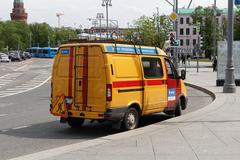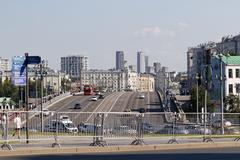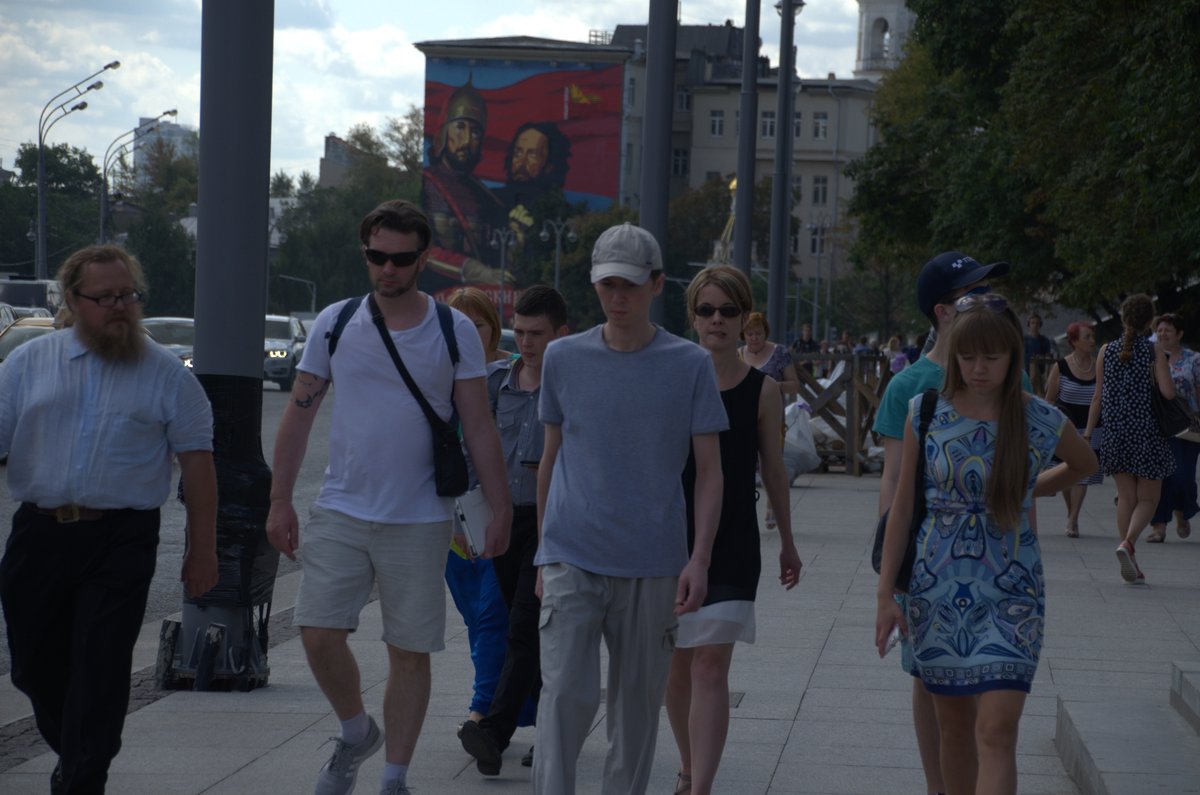
Borovitskaya Square: Visiting Hours, Tickets, and Comprehensive Tourist Guide (Moscow, 2025)
Date: 14/06/2025
Introduction
Borovitskaya Square, located at the southwestern border of the Kremlin in Moscow, is a vibrant public space steeped in centuries of Russian history. Named after the ancient Borovitsky Hill—one of the legendary seven hills on which Moscow was founded—this square and its namesake Borovitskaya Tower form a symbolic and practical gateway to the Kremlin. With architectural marvels, historical monuments, and proximity to Moscow’s most significant attractions, Borovitskaya Square is an essential destination for any visitor seeking to experience the city’s cultural and political heart (Wikipedia; Audiala).
This guide covers Borovitskaya Square’s historical evolution, architectural highlights, visitor information (including hours, ticketing, and accessibility), nearby attractions, and practical travel tips. Whether your interest lies in history, architecture, or simply exploring Moscow’s urban core, this resource provides everything you need for a memorable visit. For the latest updates and bookings, consult official Kremlin resources and the Audiala app (Kremlin Museums; Audiala).
Table of Contents
- Historical Origins and Naming
- Medieval Fortress and Renaissance Transformation
- Borovitskaya Tower: Architecture and Symbolism
- Ceremonial and Political Importance
- Soviet Era and Modern Renewal
- Visiting Borovitskaya Square and Tower
- Location and Transportation
- Facilities and Amenities
- Nearby Attractions and Suggested Itineraries
- Safety, Etiquette, and Practical Tips
- Frequently Asked Questions (FAQ)
- Conclusion
- Sources and Further Reading
1. Historical Origins and Naming
Borovitskaya Square’s origins trace back to Moscow’s earliest days. The square takes its name from “бор” (bor), meaning “pine forest,” referencing the coniferous woods that once blanketed Borovitsky Hill (Wikipedia). Archaeological evidence shows human activity here since the end of the 2nd millennium BC, with a major settlement appearing by the 11th century. In 1156, Moscow’s first wooden Kremlin fortress was established on this hill, making the site the birthplace of modern Moscow (Wikipedia; Audiala).
2. Medieval Fortress and Renaissance Transformation
The Borovitskaya Gate, which later lent its name to both the square and the tower, was integral to the wooden Kremlin constructed during Dmitry Donskoy’s reign in the late 14th century (Ermakvagus). Positioned strategically at the confluence of the Moscow and Neglinnaya Rivers, the fortress served as a defensive stronghold and facilitated trade.
In 1490, under Vasili III, the Kremlin underwent a Renaissance-inspired transformation. The Italian architect Pietro Antonio Solari (Petr Fryazin) replaced the wooden fortifications with brick and stone, introducing European techniques and aesthetics. The Borovitskaya Tower, with its iconic pyramid-like roof and sturdy base, became a lasting symbol of Moscow’s rising influence (Audiala; Ermakvagus).
3. Borovitskaya Tower: Architecture and Symbolism
Standing 50.7 meters tall (or 54.5 meters with the Soviet star), Borovitskaya Tower is a key architectural feature of the Kremlin’s western wall. Initially designed for defense, the tower evolved into a ceremonial gateway. Over the centuries, it received several modifications, including a hipped roof in the 17th century and the placement of a ruby Soviet star atop the spire in 1937 (Ermakvagus; Audiala). The tower’s enduring form and resilience have made it a symbol of statehood and continuity.
4. Ceremonial and Political Importance
Historically, Borovitskaya Tower served as a ceremonial entrance for Russian rulers, most notably during Catherine II’s coronation. Today, it is the Kremlin’s only active travel gate, used for official motorcades, state ceremonies, and visits by foreign dignitaries. A foreign flag flying atop the tower signals the presence of a visiting head of state (Friendly Local Guides).
5. Soviet Era and Modern Renewal
During the Soviet era, Borovitskaya Square underwent significant urban redevelopment, with residential blocks removed and green spaces added. The square gained renewed prominence in 2016 with the unveiling of the Monument to Vladimir the Great—a 17.5-meter statue commemorating the Christianization of Rus’ and Russia’s spiritual heritage (Kremlin.ru). Modern landscaping and lighting have further enhanced the square’s appeal (Archello; Archsovet).
6. Visiting Borovitskaya Square and Tower
Visiting Hours
- Borovitskaya Square: Open 24/7 as a public space.
- Kremlin Museums (entry near Borovitskaya Tower):
- April–October: 9:30 AM – 6:00 PM (last entry 5:00 PM)
- November–March: 10:00 AM – 5:00 PM (last entry 4:00 PM)
- Closed Thursdays (Kremlin Museums)
Tickets and Entry
- Borovitskaya Square: No ticket required, open to the public.
- Kremlin Museums: Tickets (700–1,500 RUB) for attractions like the Armoury Chamber and Diamond Fund; purchase online or at nearby ticket offices (Kremlin Museums).
- Borovitskaya Tower: Not open for interior tours; accessible for viewing from the square.
Accessibility
- Ramps and level paths throughout the square and metro station.
- Some Kremlin areas have cobblestones and steps; comfortable footwear recommended.
- Facilities cater to visitors with limited mobility, though some historical structures have access limitations.
Guided Tours and Events
- Numerous agencies and official Kremlin providers offer guided tours in multiple languages, frequently starting at or including Borovitskaya Square.
- The square hosts national ceremonies and public events, especially on holidays; check event schedules in advance (Audiala; Archsovet).
7. Location and Transportation
- Address: Borovitskaya Square, Moscow, Russia
- Metro: Borovitskaya (Line 9), connected underground to Biblioteka Imeni Lenina (Line 1) and Arbatskaya (Line 3)
- Public Transport: Metro is fastest; buses, trolleybuses, and taxis (use Yandex.Taxi or Citymobil) offer additional options (Hikersbay; SafeTravelGuide)
- Parking: Very limited; public transport is strongly recommended.
8. Facilities and Amenities
- Seating: Benches and steps throughout the square.
- Lighting: LED and architectural lighting for safety and ambiance.
- Restrooms: Available nearby (Alexander Garden, Kremlin visitor center).
- Green Spaces: Lawns and trees, with connections to Alexander Garden.
- Accessibility: Ramps and wide, even surfaces for wheelchairs and strollers.
- Wi-Fi: Free public Wi-Fi is available; local SIM cards provide reliable mobile internet.
9. Nearby Attractions and Suggested Itineraries
Key Attractions
- Kremlin Museums: Armory Chamber, Diamond Fund, Cathedral Square (Kremlin Museums)
- Monument to Vladimir the Great: 17.5-meter statue, a focal point for photos and gatherings (Kremlin.ru)
- Alexander Garden: Peaceful park with the Tomb of the Unknown Soldier
- Red Square: Home to St. Basil’s Cathedral, Lenin’s Mausoleum, and GUM department store (Travel Shark)
- Pushkin Museum of Fine Arts: Leading European art collections
Suggested Itineraries
- 1 Hour: Stroll through the square, view the monument, and enjoy Kremlin vistas.
- Half Day: Combine Borovitskaya Square, Kremlin museums, and Alexander Garden.
- Full Day: Extend visit to Red Square, St. Basil’s Cathedral, and Pushkin Museum (Pack the Suitcases).
10. Safety, Etiquette, and Practical Tips
- Safety: Central Moscow is well-patrolled; pickpocketing is rare but possible during crowded events (SafeTravelGuide).
- Etiquette: Modest dress for religious sites; respectful behavior near monuments; photography allowed in the square, but follow posted restrictions in the Kremlin (Mos-Tour).
- Weather: Best visited May–September; winters are cold and icy.
- Language: Russian is official; English common in tourist areas.
- Money: Ruble is currency; cards widely accepted but cash is useful.
- Tipping: 10–12% is standard in restaurants.
- Connectivity: Public Wi-Fi and local SIM cards are reliable.
- Families: Child-friendly, but supervise children near steps and crowds.
- Events: National ceremonies may restrict access; check advisories (Archsovet).
11. Frequently Asked Questions (FAQ)
Q: What are Borovitskaya Square’s visiting hours?
A: The square is open 24/7; the Kremlin and museums have set opening hours.
Q: Is there an entrance fee for Borovitskaya Square?
A: No, but Kremlin museums require tickets.
Q: How do I buy Kremlin museum tickets?
A: Online via the official site or at ticket offices near Borovitskaya Tower.
Q: Is Borovitskaya Tower open to visitors?
A: No, it is not accessible for tours—view from the square.
Q: Is the square wheelchair accessible?
A: Yes, with ramps and level paths.
Q: Are guided tours available?
A: Yes, in various languages, often starting at Borovitskaya Square.
Q: When is the best time to visit?
A: May to September for pleasant weather and vibrant activities.
12. Conclusion
Borovitskaya Square and Tower are pillars of Moscow’s history, blending ancient roots, Renaissance artistry, and modern political significance. The square offers not only stunning architecture and monuments but also acts as a central hub for accessing Moscow’s greatest sights. With comprehensive visitor information on hours, ticketing, transport, and accessibility, tourists can confidently plan a rewarding journey through this iconic part of the Russian capital.
For continued updates, download the Audiala app, explore related articles on Moscow’s landmarks, and follow our social media for news, events, and travel inspiration.
13. Sources and Further Reading
- Wikipedia
- Audiala
- Ermakvagus
- Friendly Local Guides
- Kremlin.ru
- Kremlin Museums
- Travel Shark
- Lonely Planet
- Pack the Suitcases
- Archsovet
- Archello
- Hikersbay
- SafeTravelGuide
- Mos-Tour
- Touropia
